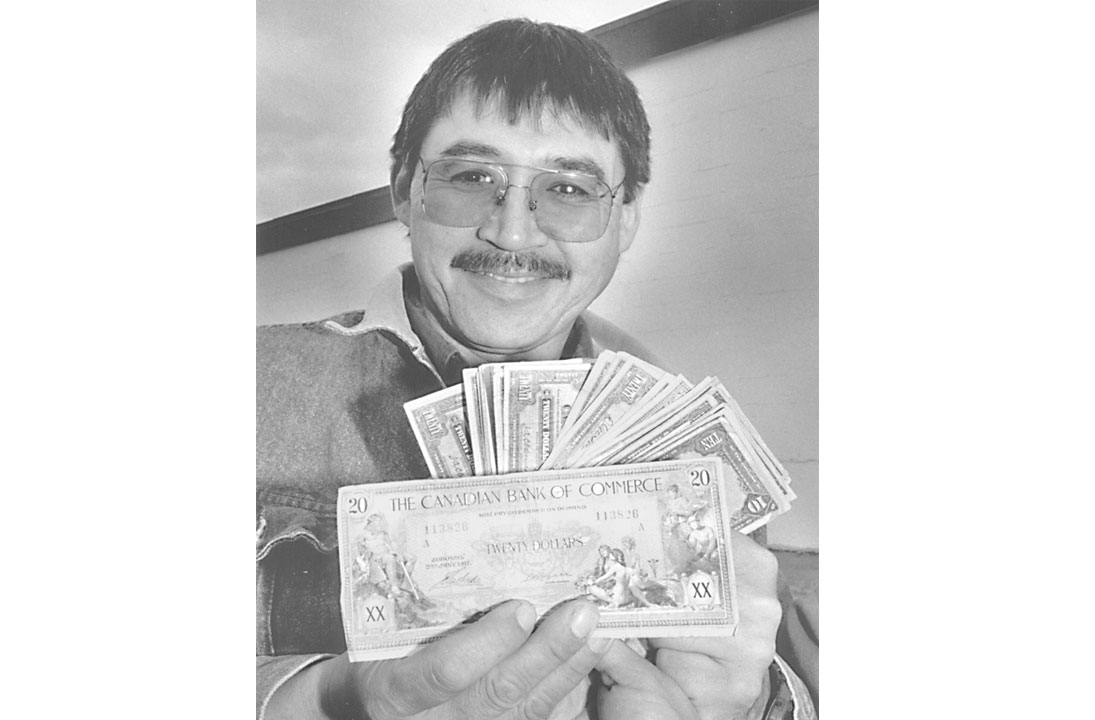
Photo by Whitehorse Star
OLD MONEY - Keith Johnson of Burwash shows off some of the $780 in old bills he and two friends discovered in an old still while hunting near Kluane Lake. Star photo by CATHIE ARCHBOULD

Photo by Whitehorse Star
OLD MONEY - Keith Johnson of Burwash shows off some of the $780 in old bills he and two friends discovered in an old still while hunting near Kluane Lake. Star photo by CATHIE ARCHBOULD
Keith Johnson and two of his friends went out on a hunting trip recently, but they came home with a very unexpected catch.
The trio from the Kluane First Nation were walking back to their truck when they came across a metal object that was partially buried by a fallen tree, roughly 70 metres from the shore of Kluane Lake near Burwash Landing.
Burwash is located some 200 kilometres northwest of Whitehorse.
“I just happened to stumble over it,” said Johnson.
At first, Johnson thought they had found an old abandoned breather from a bulldozer. But closer inspection revealed that the contraption of copper cans was actually a still for making liquor.
Finding the old still was interesting, but the real find lay inside one of the copper cans.
The hunters found a leather pouch full of papers, which the trio at first thought might be identification papers of the owner of the long-forgotten still.
However, the pouch contained a wad of 47 bills of paper money.
“At first, we thought it was American money,” Johnson recounted Tuesday, as he described the bills that were much longer and wider than today’s currency.
The money was actually Canadian, printed much earlier this century.
The party, which included Ed and Dwayne Johnson, distant relatives of Keith, found 10-,20- and 50- dollar bills, dating mostly from the mid-1930s. The oldest is a $20 bill printed 2, 1917 by the Canadian Bank of Commerce January. In all, the stack of money totalled $780. While the money was well used, all the original dyes and lettering was still intact.
Following the discovery, Dwayne grew a little philosophical back at the party’s hunt camp.
“Yep, we’ll never look at these mountains the same,” he told his friends.
Keith brought the money to Whitehorse Tuesday to deposit it in a safety deposit box at CIBC. The bank staff, he said, marvelled at the condition of the money.
During an interview following his historic bank transaction, Johnson guessed that the money and the still were likely left behind by a gold prospector in the 1930s. Following the Gold Rush era in the Klondike, some gold hunters moved down to the Kluane area and mined during the Depression.
But the still was the only sign of human activity the hunting party could find in the area.
Now people are trying to figure out how much the money might be worth.
“When I asked if they (the bank) could count for inflation, they said it would take a while,” said Keith.
The money as a currency might still only be worth its face value, but as a collectible it could be worth much more.
Keith has already done some research and uncovered that coin brokers value 1935 $10 bills at around $125 each. Twenty dollar bills can be worth $160.
Johnson, a 44-year-old heavy equipment operator, hasn’t decided what to do with the money, but he figures the museum in Burwash might be interested in the still, which the hunting party also kept.
John McHutchion, Star reporter
In order to encourage thoughtful and responsible discussion, website comments will not be visible until a moderator approves them. Please add comments judiciously and refrain from maligning any individual or institution. Read about our user comment and privacy policies.
Your name and email address are required before your comment is posted. Otherwise, your comment will not be posted.
Be the first to comment